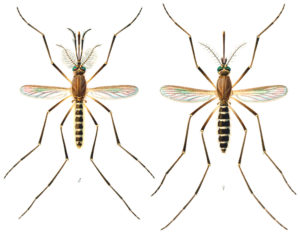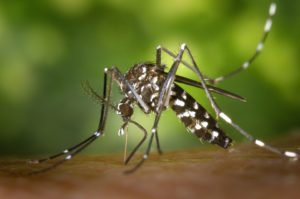Mosquitoes are a group of small fly-like insects that have a slender segmented body, a pair of wings, three pairs of long hair-like legs, feathery antennae, and elongated mouthparts.
Typically, both male and female mosquitoes feed on nectar and plant juices. In many species however, the female needs to obtain nutrients from a blood meal before it can produce eggs. As a result, the mouthparts of these females are adapted for piercing the skin of animal hosts and sucking their blood. During this process, mosquitoes can inject and/or ingest disease-causing organisms with their bite and are thus a vector for the transmission of diseases such as malaria, yellow fever, Chikungunya, West Nile virus, dengue fever, Zika virus and others.
The above mentioned diseases are transmitted between humans, but mosquitoes are also responsible for transmitting pathogens that can infect birds. Diseases like avian malaria and avian poxvirus can cause deformities and death in birds that have not developed any defense against them.
“Without question, the one factor that prevented widespread and rapid extinction of virtually all of Hawaii’s native honeycreepers after the introduction of avian malaria was the presence of high-altitude disease refuges on Kauai, Maui and Hawaii,”
Dr. Carter Atkinson, a U.S. Geological Survey (USGS) microbiologist based at the USGS Pacific Islands Ecosystems Research Center in Hawaii.
Mosquito Abatement
Current mosquito control methods are inadequate for the control of invasive mosquitoes and the diseases they carry. Current methods are not efficient or effective at larger scales, nor are they cost effective, or practical and they present many ecological and public health challenges. A range of control techniques are currently being evaluated in order to find a way to protect native Hawaiian birds and ecosystems. This requires the cooperation of many different partners and agencies. It also requires a better understanding of the population dynamics of mosquitos in remote forested regions. KFBRP must conduct frequent and rigorous stream surveys in order to better understand where and mosquitos are found and what species they are. To learn more about how these stream surveys work, please refer to this video on our Youtube Channel.
With climate change predictions, there is an urgency now to work with partners to find solutions that work for people, native forest birds, and Hawaii’s native ecosystems as a whole. Technologies have only recently been developed where control could be addressed at larger scales. These technologies include the use of Wolbachia, a naturally occurring bacteria that could be used as mosquito birth control. Wolbachia have been used successfully in other parts of the world as illustrated by this video. Please refer to the video below to see how Wolbachia may work to control mosquitos in Hawaiʻi.








